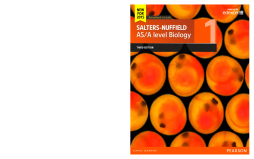
BOOK
Salters-Nuffield AS/A level Biology Student Book 1
University of York Science Education Group | Curriculum Centre Nuffield
(2016)
Additional Information
Book Details
Abstract
Salters-Nuffield AS/A level Biology Student Book 1
Table of Contents
| Section Title | Page | Action | Price |
|---|---|---|---|
| Cover | Cover | ||
| Contents | iii | ||
| Contributors | iv | ||
| About the SNAB course | v | ||
| How to use this book | vi | ||
| Topic 1: Lifestyle, health and risk | 2 | ||
| Mark’s story | 4 | ||
| Peter’s story | 5 | ||
| 1.1: What is cardiovascular disease? | 6 | ||
| How does the circulation work? | 8 | ||
| The transport medium | 8 | ||
| What is atherosclerosis? | 14 | ||
| 1.2: Who is at risk of cardiovascular disease? | 18 | ||
| Probability and risk | 18 | ||
| Different types of risk factor | 20 | ||
| 1.3: Risk factors for cardiovascular disease | 22 | ||
| Identifying risk factors for CVD | 22 | ||
| Risk factors for CVD | 25 | ||
| Age and gender make a difference | 26 | ||
| High blood pressure | 27 | ||
| Dietary factors | 29 | ||
| Where do we get energy from in our diet? | 30 | ||
| Smoking | 43 | ||
| Inactivity | 44 | ||
| My dad had a heart attack - will I? | 44 | ||
| Other risk factors | 46 | ||
| 1.4: Reducing the risks of cardiovascular disease | 48 | ||
| Diuretics | 49 | ||
| Thinking Bigger | 54 | ||
| Topic 2: Genes and health | 56 | ||
| 2.1: The effects of CF on the lungs | 58 | ||
| The role of mucus in the lungs | 58 | ||
| CF problems | 60 | ||
| Gas exchange surfaces | 61 | ||
| 2.2: Why is CF mucus so sticky? | 63 | ||
| Cell membrane structure | 65 | ||
| How do substances pass through cell membranes? | 69 | ||
| What happens in the membranes of the cells lining the airways? | 73 | ||
| 2.3: How does cystic fibrosis affect other body systems? | 76 | ||
| The effect of CF on the digestive system | 76 | ||
| The effect of CF on the reproductive system | 79 | ||
| The effect of CF on sweat | 80 | ||
| 2.4: How is the CFTR protein made? | 80 | ||
| The structure of DNA | 80 | ||
| How does DNA code for proteins? | 83 | ||
| 2.5: What can go wrong with DNA? | 89 | ||
| DNA replication | 89 | ||
| 2.6: How is cystic fibrosis inherited? | 93 | ||
| How genes are passed on | 93 | ||
| Inheritance of some human genetic diseases | 95 | ||
| The work of Mendel | 95 | ||
| 2.7: Testing for CF | 96 | ||
| Genetic testing | 96 | ||
| Making ethical decisions - what is right and what is wrong? | 98 | ||
| Thinking Bigger | 102 | ||
| Topic 3: Voice of the genome | 104 | ||
| 3.1: In the beginning | 106 | ||
| Getting started | 110 | ||
| 3.2: From one to many: the cell cycle | 119 | ||
| The cell cycle | 120 | ||
| Early embryonic development - stem cells | 126 | ||
| 3.3: How development is controlled | 132 | ||
| 3.4: Genes and environment | 140 | ||
| Is it all in the genes? Nature and nurture | 140 | ||
| Gene and environment interactions | 142 | ||
| Thinking Bigger | 148 | ||
| Topic 4: Biodiversity and natural resources | 150 | ||
| 4.1: Why are there so many different species? | 152 | ||
| Species occupy different niches | 153 | ||
| Adapted to their environments | 155 | ||
| 4.2: How did organisms become so well adapted? | 158 | ||
| Natural selection | 158 | ||
| 4.3: Quantifying biodiversity | 163 | ||
| What is biodiversity? | 163 | ||
| Unlocking identities | 164 | ||
| Sorting and grouping | 166 | ||
| Biodiversity within a species | 170 | ||
| Measuring biodiversity | 172 | ||
| 4.4: Making use of biodiversity | 175 | ||
| How are plants adapted to survive? | 175 | ||
| Building tall structures | 176 | ||
| Cell walls - the secret of their strength | 178 | ||
| Tubes for transport and strength | 181 | ||
| Phloem sieve tubes and transport | 185 | ||
| Solutes are actively transported into and out of the phloem | 186 | ||
| Mass transport in phloem sieve tubes | 187 | ||
| Xylem and sclerenchyma for support | 188 | ||
| Useful plant fibres | 188 | ||
| Chemical defences against attack | 189 | ||
| Digitalis and drug development | 191 | ||
| Seeds for survival | 193 | ||
| 4.5: On the brink | 197 | ||
| The role of zoos | 197 | ||
| Centres for scientifi c research | 198 | ||
| Reintroducing animals into the wild | 201 | ||
| The Millennium Seed Bank (MSB) | 202 | ||
| Thinking Bigger | 204 | ||
| Answers | 206 | ||
| Index | 219 |
